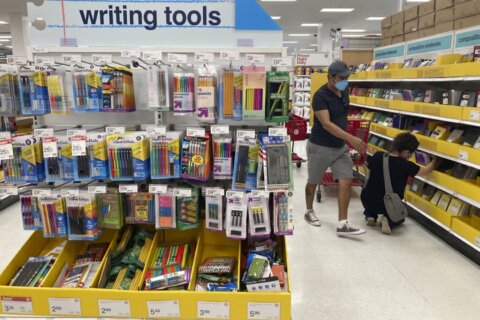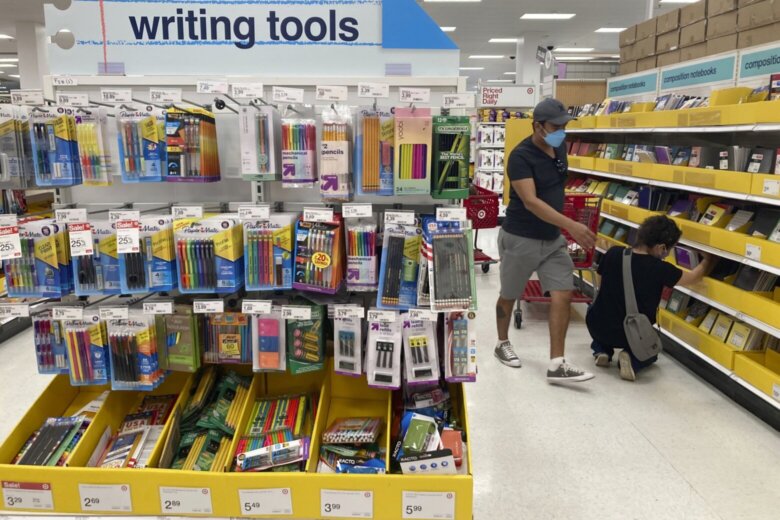
Somehow, we live in a time when it’s considered normal for teachers to routinely buy school supplies for their students.
If you’re a teacher, how much are you likely to spend on school supplies in 2023? It’s hard to say, but it would be wise to budget at least several hundred dollars.
According to Office Depot’s 3rd Annual Back-to-School Survey, which asked questions of 1,000 parents of kids ages 5 to 17 and 1,000 K-12 teachers, parents were planning to set aside $225 for back-to-school supplies. Teachers expect to spend even more: $320 of their own money on school supplies for the 2023-2024 school year.
So what type of school supplies are teachers buying? And is it really necessary that teachers buy school supplies? What should you do if you’re a teacher who is on a tight budget? These are all good questions with no easy answers.
What school supplies are teachers buying? If a student needs it and can’t afford it, chances are, a teacher is buying it. But it generally breaks down as follows:
Teachers are buying what you would expect. Plus some extras. “I buy pens, pencils, tissues, paper and notebooks,” says Valerie de la Rosa, a Los Angeles middle school teacher behind the blog, “The Weary Educator.”
Over the 14 years she has been teaching English, de la Rosa has also bought necessities such as backpacks, uniforms, jackets and, one year, for one student, eyeglasses.
“I spend at least $500 each year on supplies,” de la Rosa says. “I consider it the cost of being able to do my job properly. Kids can’t learn if they don’t have the basic materials they need.”
Teachers are also buying what you would not expect. Jennifer Eisenreich, a former teacher and principal in Pittsburgh, says teachers routinely buy snacks for kids whose parents can’t afford them. Teachers may also buy cushions and furniture so kids don’t have to sit in rows of desks. Plants, ambient lighting, rugs, books for the classroom library, underwear and socks, and disinfecting wipes are also possible purchases.
Eisenreich says it’s almost common for teachers to purchase a mini-fridge and microwave for the classroom if there is not a faculty room. “Many are now being used for learning spaces,” she says.
Teachers tend to spend the most during their first year. Robert Draves, who teaches eighth grade social studies in Gwinnett County, Georgia, says that when he first started at his current school four years ago, he spent around $400, and after that, about $200 a year.
“It is cyclical. Every few years I find myself spending a considerable amount,” Draves says.
Stephanie Lenzi, a sixth-grade social studies teacher at a middle school in Warwick, Rhode Island, says she tends to spend between $200 to $300 on school supplies like pencils, folders, tissues, sanitizer and hygiene products. “Many of my students’ families just don’t have access to everything they’ll need,” she says.
“One of the most important things teachers can do for their students is create a welcoming learning environment. And unfortunately, most classrooms do not come equipped with beautifully painted walls, nice hardwood floors and interesting textures and fabrics,” says Jennifer Holt, a resident of Mountain City, Tennessee, founder of the blog, “Happy Teacher Mama” and an ELA (English language arts) interventionist for second, third and fourth grade students.
“So teachers spend their hard-earned dollars on classroom decor that will cover over the chipped cinder block walls, peeling linoleum floors and broken cabinets in order to make their classrooms feel less sterile and more homey,” Holt says.
Teachers specializing in a subject may spend even more. Every teacher has their own type of spending challenges, according to Tiana Woolard, an eighth-grade science teacher in Upper Marlboro, Maryland.
“Most teachers spend upwards of $500 for basics such as pencils, notebooks, paper and folders,” she says. “If you teach science or physical education, those prices easily surpass $2,000 over a school year.”
“Microscopes can be very expensive, and electronic scales,” Woolard adds.
Teachers aren’t just spending at the beginning of the school year. Students may need replacement supplies throughout the year, Lenzi says.
“A good chunk is spent on classroom setup, visuals and different items to promote a positive learning environment. Some is spent through the year, once I know the kids better and see what they might need, or on classroom incentives and team activities,” Lenzi says.
According to Holt, it’s not uncommon for teachers to spend over $1,000 each year with their first-year expenditures reaching upward of $2,000.
She adds: “This may sound like an overinflated number until you realize that $1,000 is only $100 per month for the 10 months students are present.”
[Survey: Nearly 71% Say Back-to-School Expenses Are a Challenge]
Is It Necessary That Teachers Buy School Supplies?
Yes and no. Teachers don’t have to buy any child school supplies, but many do.
“It’s really important to me that children have what they need to be successful and don’t have to worry about being embarrassed when they don’t have something or can’t contribute to a classroom party or something like that,” Lenzi says.
Unfortunately, schools don’t often have the budget to cover the necessary school supplies for each classroom.
“Typically, teachers receive a classroom budget, which varies widely from district to district, state to state. That budget has to cover everything from pencils to name tags to curriculum needs and all the things needed to create a bright, exciting learning space,” Eisenreich says.
“We get exactly one cartridge of ink, one ream of paper, a box of tissues, a pack of whiteboard markers and six boxes of pencils each,” de la Rosa says.
“The public school system can and should do better to minimize the financial stress created by a seemingly random process for stakeholders to obtain key school supplies,” says Hamlet Hernandez, an assistant teaching professor of education at Quinnipiac University in Hamden, Connecticut. He has also been a school superintendent, principal and teacher.
Hernandez adds, “At the root of this issue is public school funding. School budgets are predominantly consumed by wages, insurance and other operational costs with little, if any, funds remaining to systematically purchase school supplies.”
[READ: Ways to Teach Kids About Money.]
What Should You Do If You’re a Teacher Who Isn’t Rich?
Many teachers aren’t rich. The median elementary school teacher’s salary is $61,400 a year.
There are several strategies teachers typically use to help offset their spending on school supplies.
DonorsChoose. This a highly regarded nonprofit that many teachers swear by, which lets individuals directly donate to public school classroom projects. Teachers can go to the site and explain what project they want to teach and what materials they’ll need.
For example, teachers may ask for a moveable easel to make lessons more engaging. Or they may request a bookstand or books.
Grants for teachers. There are a lot of nonprofits that offer grants for teachers. Woolard says she has had some luck getting funds for science projects.
Other organizations. Lots of organization raise money for school supplies, although many nonprofits give the school supplies directly to children, which presumably offsets a lot of costs for teachers.
For example, the Kids in Need Foundation works with dozens of organizations throughout the country to help distribute school supplies to students, and United Way routinely does school supply drives around the start of the school year.
This year, Draves got lucky. “Teachers in the state were given a $300 Office Depot credit for supplies, which really helped update some items that needed it,” he says, adding that the supplies he purchased included electric pencil sharpeners, staplers, colored pencils, markers and whiteboards.
“I will probably end up spending around that $200 mark again this year in addition to the $300 credit,” Draves says.
Keep your receipts. You’ll need them when you file your taxes. Mark Steber, Jackson Hewitt’s chief tax information officer, says, “Teachers and educators will be able to deduct up to $300 of qualifying out-of-pocket classroom expenses this year.”
Steber adds that the educator expense deduction is available to taxpayers who are kindergarten through grade 12 teachers, instructors, counselors, principals or aides who worked in a school for at least 900 hours during the school year.
Shop for discounts. Clearance racks sometimes have affordable school supplies, as do garage sales.
Woolard says she often goes to Walmart, crossing her fingers that there’s a sale on school supplies. “Dollar Tree is definitely our friend,” she says. And teachers, it’s safe to say, are everybody’s friend.
More from U.S. News
How to Save Money for Your Kids
Ways to Save for Your Child’s College Education
Help Your Kids With Finances Without Jeopardizing Your Own
This is How Much It Costs Teachers to Get School Supplies originally appeared on usnews.com








